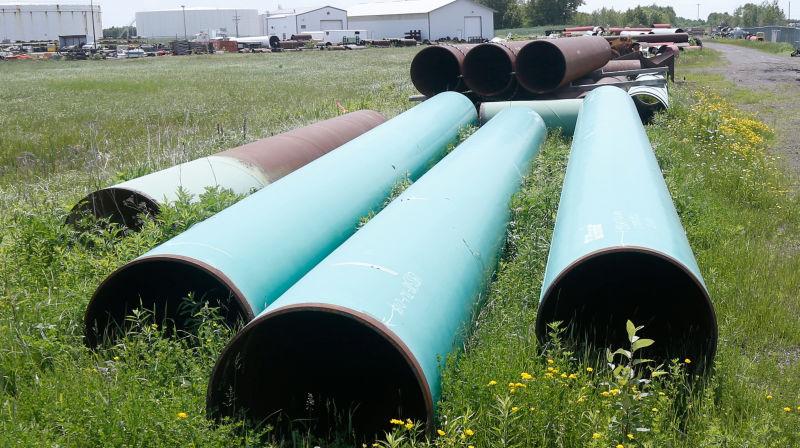One of The Nation's Largest Pipelines Caused The Biggest Spill in Decades-And We're Just Hearing About It
By: Molly Taft (MSN)



Unless you're living in Huntersville, North Carolina, you may be blissfully unaware that the U.S.'s biggest gasoline spill since 1997 happened this past summer. The slowly-unfolding, little-reported-on saga in the state involves a company controlled by special interests like the Koch brothers and Shell, and a pipeline that has been transporting dirty energy for decades. And the crisis of the Colonial pipeline points to one of the next big issues for American fossil fuel infrastructure: what to do about dangerous, aging pipelines as we move to clean energy.

 © Photo: Jim Mone (AP) Pipelines used to carry crude oil.
© Photo: Jim Mone (AP) Pipelines used to carry crude oil.
In August, two teenagers riding ATVs around in a nature preserve outside of Huntersville, a suburb north of Charlotte, noticed gasoline gurgling out of the ground and told the town fire department. (Colonial's owners told some state lawmakers a different story, initially claiming that they'd shut down the pipeline after noticing a pressure drop at another point in the line.) At first, the pipeline company reported that only 63,000 gallons of oil had been spilled, but throughout the fall, that number steadily crept up: 273,000 gallons in September, 311,000 gallons in November. The company now says nearly 1.2 million gallons have been leaked; that number could still rise as more assessments are done.
While pipeline owners tend to undershoot their initial estimates of spills, this level of screwup is "somewhat astronomical and not normal," said Jared Margolis, a senior attorney at the Center for Biological Diversity. Margolis said that gasoline's physical composition—it sinks to the bottom of bodies of water, unlike oil, which stays slick on top—could make spills like this harder to gauge.
The Keystone Pipeline Is Running Again Two Weeks After Major Spill
But the age of the pipeline, Margolis said, was also probably a culprit in how the exact number was missed. Unlike newer pipelines, older ones like the Colonial pipeline "don't have the same mechanisms in place to monitor spills and leaks," he said. "This is a 40-some-year-old pipeline, it just doesn't have that kind of technology."
The Colonial pipeline is owned by a company of the same name, which is, in turn, controlled by companies including Koch Industries (its largest shareholder, which made $85 million in dividends from the pipeline in 2016) and Royal Dutch Shell. The pipeline was initially built in 1963, and stretches from Texas to New Jersey. According to the company, the pipeline transports around 2.5 million barrels of fuel per day, mostly underground, that supplies 45% of the entire East Coast's gasoline. In 2016, North Carolina alone got 70% of its gasoline from the pipeline. Its owners have said that technology can detect leaks as small as 3% of the pipeline's daily flow-which works out to around 1.8 million gallons.
Colonial Pipeline (the company) has been doing damage control since the summer. As officials continued to gradually and quietly raise estimates of the spill in the press, it simultaneously bought out three properties near the leak site, spending more on those purchases than it's spent on environmental penalties levied over the past three decades. Yet the company has not disclosed the cause of the five-foot crack in the pipe segment outside of Charlotte. (That same line segment had also been repaired in 2004.)
Margolis pointed out that the Colonial pipeline is so old that its anti-corrosion mechanism is simply a coating of coal tar. "That's scary," he said, pointing out that newer pipelines with updated technology still have accidents.
"When you think about Keystone 1, what's in the ground, that thing leaked, like, fifteen times the first year or two, and that supposedly had all the bells and whistles, all the new technology," he said, referencing the numerous accidents the TC Energy-owned pipeline, the predecessor to the Keystone XL project, has had in its 10-year existence. "What we're talking about here is a whole step removed from that-they basically painted it with tar and threw it in the ground."
Anti-pipeline activists tend to focus their attention on new infrastructure being built (and for good reason). New construction represents locking the world into new emissions, and it's much harder to argue for pulling the plug on a pipeline the size of Colonial's, which would represent a significant disruption in our daily lives if it was to suddenly disappear. The 2016 back-to-back spill and explosion, for example caused gas shortages in six states.
Yet Colonial may represent the next step forward in fighting for an energy transition: figuring out how to decommission pipelines that are falling apart.
"There aren't that many pipelines proposed for the near future. We know they're not economical, we know we need to move beyond fossil fuels, so at this point, it's like, what's the next issue with pipelines?" Margolis said, pointing out that pipelines like Colonial are particularly dangerous in terms of explosions, water pollution, and other on-the-ground impacts. "There's a couple ways to deal with this aging infrastructure. The big way, the main way we see it, is that these things should be decommissioned. When you see a pipeline that's this old with these kinds of problems. It shouldn't be repaired, it should be shut down."
There are around 190,000 miles of pipelines that transport liquid petroleum products across the U.S. Deactivating pipelines is a messy, protracted affair, with several steps required from regulatory bodies to make sure it's done correctly. It's also expensive: Enbridge has estimated that properly deactivating its aging Line 3 pipeline and taking it out of the ground would cost more than $1.2 billion dollars. The company is currently considering simply abandoning it and paying off the landowners involved, which it says would cost a relatively paltry $85 million, but leave corrosive pipes littered underneath the landscape.
Activists opposing new pipelines also haven't stopped fighting them even after being built. The resistance to the Dakota Access pipeline morphed from blocking construction to shutting off a functioning pipeline after Trump lifted blocks set by his predecessor and allowed the pipeline to begin transporting oil. However, in July of last year, a judge ruled that the government did not complete an adequate impact assessment
For older pipelines like Colonial, which have been around long enough to survive any legal challenges related to their initial construction, the chance for shutdown could come when the owners make moves to make significant repairs-especially if those repairs cross new territories or require new permits. That struggle is playing out right now in Minnesota, where Enbridge is looking to construct a new pipeline to replace the crumbling Line 3. The company's proposed route for the replacement is facing legal challenges and significant backlash from Indigenous groups and activists who say the pipeline violates treaty rights with tribes in the area.
Just because pipelines like the Line 3 replacement or Colonial aren't technically new infrastructure doesn't mean that they can't keep the U.S. locked into using dirty fuels. If shareholders spend big to keep a pipeline working, they'll be less and less interested in suddenly doubling back on that investment.
"If you rebuild a pipeline, just like building a new pipeline, you're putting millions and millions of dollars into it," Margolis said. "You're locking us into fossil fuel use for decades."

 Article is LOCKED by moderator [Split Personality]
Article is LOCKED by moderator [Split Personality]




It appears from our history, that the greatest discovery of all time will be
when someone makes something entirely leak proof.
Every car and home I ever had has leaked something. The Failed Challenger seals were a big Leak.
Spacex Starship SN10 landed successfully the other day, caught fire and blew up. They are investigating a fuel leak...
there's a reason why big oil wants most production where few can see it.
The carbon boys have been busy:
What Greg #3 below ignored:
The nation's more than 2.6 million miles of pipelines safely deliver trillions of cubic feet of natural gas and hundreds of billions of ton/miles of liquid petroleum products each year. They are essential: the volumes of energy products they move are well beyond the capacity of other forms of transportation. It would take a constant line of tanker trucks, about 750 per day, loading up and moving out every two minutes, 24 hours a day, seven days a week, to move the volume of even a modest pipeline. The railroad-equivalent of this single pipeline would be a train of 225, 28,000 gallon tank cars.
Pipelines are here to stay. Leaks happen.
So you are saying that a ( current tabulation ) 1.2 million gallon gasoline leak is acceptable?
Yes. Leaks happen, shit happens and Greg doesn't care as long as he has his.
I know, I seeded the article. Did you read it?
If you have something to contribute please do so, but park the attitude that you have brought over
from the other seed somewhere else please.
You're getting way too personal.
[deleted]
Where is he too personal ? You and Tex appear to be arguing that MILLIONS of GALLLONS of fuel, dumping into our environment , is cool, with you two. Well It's NOT COOL, and avoidable.
Good article. Tragic thing is that this is the norm,,,it happens all over and nothing changes. North Dakota is becoming legendary for it’s oil spills, and toxic water used in excavating oil, also spilling; spills that largely go unnoticed by most.


(6 year old map, there at many more since then)
map of oil spills just between 2010 and 2015